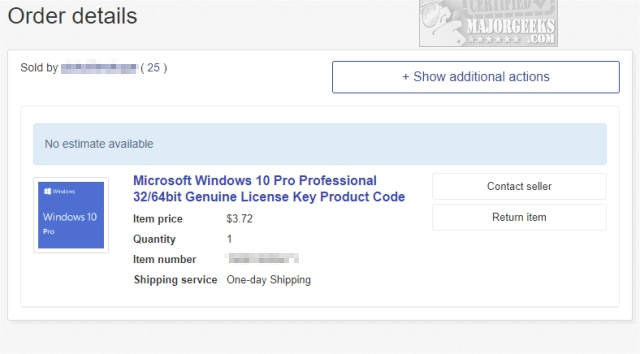How to Upgrade to Windows 10 for Free in 2021
By Timothy Tibbettson 07/18/2023 |
When Windows 10 was released, upgrading was free for all Windows users. As time progresses, there are fewer ways to upgrade for free. Because Microsoft wants to show Windows 10 was a success and wants everyone off the expiring Windows 7, there remain a few possibilities to upgrade to Windows 10 for free.
Microsofts giving away of Windows 10 has worked, although not as much as they hoped, partly because of the death of Windows Phone. Microsoft had planned to reach one billion devices within three years. While they missed that goal and reached approximately 700 million users, they did accomplish Windows 10, surpassing Windows 7 users.
Microsoft has allowed "loopholes," but they have begun closing them, including the free upgrade for assistive technologies users, which always felt sleazy to us anyways. There remain two possible ways to upgrade to Windows 10 for free.
1: Use a Windows 7, Vista, or 8 Key
If you install Windows 10, you can try to enter your product key from Windows 7, Vista, or 8. The problem is that it works for some and fails for others.
We've skimmed the success and failure stories to try and understand. We know that product keys can be on the hardware (tower or laptop), included with a DVD, or embedded in the BIOS. However, we noted three standouts with people who couldn't upgrade.
1: Older computers. We're wondering about a set date or maybe computers that came with a DVD.
2: Changed hardware. If you're upgrading on a computer that's had multiple upgrades, Windows might think it's a new computer.
3: Windows 8. There's a serious number of people who couldn't upgrade with their Windows 8 key, while Windows 7 users had much more success. We're assuming Microsoft wants to continue to get people off of Windows 7.
2: Don't Use a Product Key
Microsoft no longer forces you to use a product key. There's an option to enter your product key later during installation. Now, Windows 10 is installed and will continue to receive Windows updates, and Windows 10 is fully functional except for two things.
1: Windows 10 locks all personalization settings, including Themes, Background, Colors, Lock Screen, Themes, Fonts, Start Menu, and Taskbar. We were able to change our background and lock screen.
2: You will eventually see the words Activate Windows in the lower-right corner.
If you don't use your computer a lot, odds are you can live with these limitations.
3: In Closing
Sadly, upgrading to Windows 10 for free is now a big, fat maybe.
While this article focuses on upgrading for free, or you can't upgrade and don't want to live with the crippled "free" version of Windows 10, check out how we purchased a cheap product key for less than four bucks that continue to work four months later.

There are some great related articles below that you might find of interest.
Similar:
Do Cheap Windows 10 Keys Really Work?
Will Windows 10 Receive Windows Updates if It's Not Activated?
8 Ways to Activate Windows 10
Can I Have Multiple Windows 10 or Microsoft Office Keys One One Account?
Create a Windows 10 Bootable USB Flash Drive With Windows 10 Media Creation Tool
How to Activate After Reinstalling Windows 10
comments powered by Disqus
Microsofts giving away of Windows 10 has worked, although not as much as they hoped, partly because of the death of Windows Phone. Microsoft had planned to reach one billion devices within three years. While they missed that goal and reached approximately 700 million users, they did accomplish Windows 10, surpassing Windows 7 users.
Microsoft has allowed "loopholes," but they have begun closing them, including the free upgrade for assistive technologies users, which always felt sleazy to us anyways. There remain two possible ways to upgrade to Windows 10 for free.
1: Use a Windows 7, Vista, or 8 Key
If you install Windows 10, you can try to enter your product key from Windows 7, Vista, or 8. The problem is that it works for some and fails for others.
We've skimmed the success and failure stories to try and understand. We know that product keys can be on the hardware (tower or laptop), included with a DVD, or embedded in the BIOS. However, we noted three standouts with people who couldn't upgrade.
1: Older computers. We're wondering about a set date or maybe computers that came with a DVD.
2: Changed hardware. If you're upgrading on a computer that's had multiple upgrades, Windows might think it's a new computer.
3: Windows 8. There's a serious number of people who couldn't upgrade with their Windows 8 key, while Windows 7 users had much more success. We're assuming Microsoft wants to continue to get people off of Windows 7.
2: Don't Use a Product Key
Microsoft no longer forces you to use a product key. There's an option to enter your product key later during installation. Now, Windows 10 is installed and will continue to receive Windows updates, and Windows 10 is fully functional except for two things.
1: Windows 10 locks all personalization settings, including Themes, Background, Colors, Lock Screen, Themes, Fonts, Start Menu, and Taskbar. We were able to change our background and lock screen.
2: You will eventually see the words Activate Windows in the lower-right corner.
If you don't use your computer a lot, odds are you can live with these limitations.
3: In Closing
Sadly, upgrading to Windows 10 for free is now a big, fat maybe.
While this article focuses on upgrading for free, or you can't upgrade and don't want to live with the crippled "free" version of Windows 10, check out how we purchased a cheap product key for less than four bucks that continue to work four months later.

There are some great related articles below that you might find of interest.
Similar:
comments powered by Disqus






